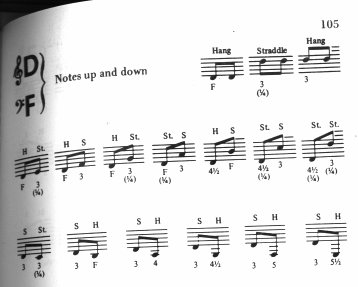| [ << Music engraving ] | [Top][Contents][Index] | [ Literature list >> ] |
| [ < Automated engraving ] | [ Up: Automated engraving ] | [ Improvement by benchmarking > ] |
Beauty contests
How do we actually make formatting decisions? In other words, which of the three configurations should we choose for the following slur?
![[image of music]](../3f/lily-ac354203.png)
There are a few books on the art of music engraving available. Unfortunately, they contain simple rules of thumb and some examples. Such rules can be instructive, but they are a far cry from an algorithm that we could readily implement in a computer. Following the instructions from literature leads to algorithms with lots of hand-coded exceptions. Doing all this case analysis is a lot of work, and often not all cases are covered completely:
(Image source: Ted Ross, The Art of Music Engraving)
Rather than trying to write detailed layout rules for every possible scenario, we only have to describe the objectives well enough that LilyPond can judge the attractiveness of several alternatives. Then, for each possible configuration we compute an ugliness score and we choose the least ugly configuration.
For example, here are three possible slur configurations, and LilyPond has given each one a score in ‘ugly points’. The first example gets 15.39 points for grazing one of the noteheads:
![[image of music]](../a6/lily-891b625e.png)
The second one is nicer, but the slur doesn’t start or end on the note heads. It gets 1.71 points for the left side and 9.37 points for the right side, plus another 2 points because the slur ascends while the melody descends for a total of 13.08 ugly points:
![[image of music]](../43/lily-f0f2135c.png)
The final slur gets 10.04 points for the gap on the right and 2 points for the upward slope, but it is the most attractive of the three configurations, so LilyPond selects this one:
![[image of music]](../a4/lily-8ec4148f.png)
This technique is quite general, and is used to make optimal decisions for beam configurations, ties and dots in chords, line breaks, and page breaks. The results of these decisions can be judged by comparison to real engravings.
| [ << Music engraving ] | [Top][Contents][Index] | [ Literature list >> ] |
| [ < Automated engraving ] | [ Up: Automated engraving ] | [ Improvement by benchmarking > ] |
